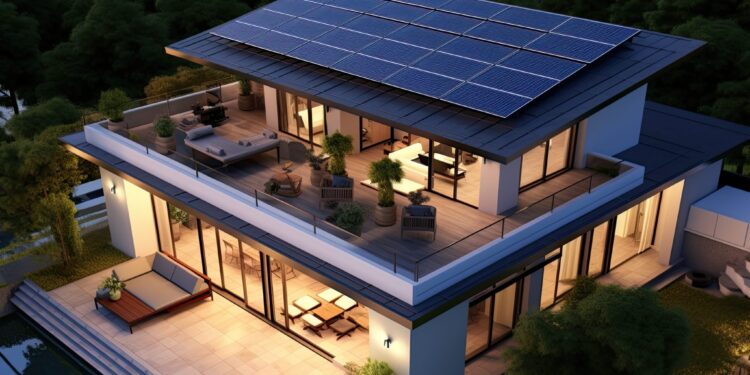Energy-efficient exterior lighting solutions set the stage for a captivating exploration of how outdoor spaces can be transformed with sustainable and cost-effective lighting options. From defining energy-efficient lighting to discussing its impact on the environment and savings, this topic delves into the practical and eco-friendly aspects of lighting design.
As we delve deeper into the types of fixtures, considerations for selection, and installation tips, readers will gain valuable insights into creating well-lit outdoor spaces that are both energy-efficient and visually appealing.
.
Overview of Energy-efficient Exterior Lighting Solutions
Energy-efficient exterior lighting refers to lighting fixtures and systems designed to minimize energy consumption while providing adequate illumination for outdoor spaces. These solutions are specifically engineered to reduce energy waste and promote sustainability. The importance of energy-efficient lighting solutions in outdoor spaces cannot be overstated. Not only do they help to lower energy bills and reduce carbon footprint, but they also enhance safety and security in exterior environments. By using energy-efficient lighting, property owners can create well-lit outdoor areas without sacrificing environmental responsibility.Contribution to Sustainability and Cost Savings
- Energy-efficient exterior lighting solutions utilize LED technology, which consumes significantly less energy compared to traditional incandescent bulbs. This results in reduced electricity consumption and lower utility costs over time.
- By reducing energy usage, these lighting solutions contribute to the overall goal of sustainability by decreasing greenhouse gas emissions and minimizing environmental impact.
- Moreover, the longevity of LED bulbs means less frequent replacements, translating to savings on maintenance and replacement costs for property owners.
- Overall, energy-efficient exterior lighting not only benefits the environment but also offers long-term financial savings for individuals and businesses alike.
Types of Energy-efficient Exterior Lighting Fixtures
When it comes to energy-efficient exterior lighting solutions, there are several types of fixtures available to choose from. Each type comes with its own set of features and benefits, making it important to understand the differences between them.LED Fixtures
- LED fixtures are known for their energy efficiency and long lifespan.
- They provide bright and focused lighting, making them ideal for outdoor spaces.
- LED fixtures consume less energy compared to traditional lighting options, resulting in lower electricity bills.
Solar-Powered Fixtures
- Solar-powered fixtures rely on sunlight to generate power, making them a sustainable and eco-friendly option.
- They are easy to install and require minimal maintenance once set up.
- These fixtures are ideal for areas with ample sunlight exposure, providing a reliable source of outdoor lighting.
Motion Sensor Fixtures
- Motion sensor fixtures are designed to only activate when motion is detected, helping to conserve energy.
- They provide added security by illuminating outdoor spaces when movement is sensed.
- These fixtures are a great option for pathways, driveways, and other areas that are not always in use.
Considerations for Selecting Energy-efficient Exterior Lighting
When choosing energy-efficient lighting solutions for outdoor areas, there are several factors to consider to ensure optimal performance and savings. Color temperature and brightness play a crucial role in outdoor lighting design, affecting visibility, ambiance, and energy consumption. Calculating the energy savings potential of different lighting options can help determine the most cost-effective and sustainable solution for your outdoor spaceImpact of Color Temperature and Brightness
Color temperature and brightness levels can significantly impact the effectiveness and efficiency of outdoor lighting. Warmer color temperatures (around 2700K) can create a cozy and inviting atmosphere, ideal for residential areas or hospitality settings. On the other hand, cooler color temperatures (5000K or higher) are suitable for security lighting in commercial or industrial spaces, providing better visibility and a sense of safety.It is essential to strike a balance between color temperature and brightness levels to achieve the desired lighting effects while minimizing energy consumption.
Calculating Energy Savings Potential
To calculate the energy savings potential of different lighting options, consider factors such as wattage, operating hours, and energy costs. Compare the energy consumption of traditional incandescent or halogen bulbs with energy-efficient LED or CFL fixtures to determine the long-term savings. Energy-efficient lighting fixtures with lower wattage and longer lifespan can offer substantial energy savings over time, making them a sustainable choice for outdoor lighting solutions.Installation and Maintenance Tips for Energy-efficient Exterior Lighting
Installing and maintaining energy-efficient exterior lighting fixtures is essential to maximize their performance and longevity while minimizing energy consumption.Step-by-step Guide for Installing Energy-efficient Exterior Lighting Fixtures
- Choose the right fixture: Select energy-efficient LED fixtures that are suitable for outdoor use.
- Turn off power: Before installation, ensure the power source is switched off to prevent any accidents.
- Mount the fixture: Follow the manufacturer's instructions to securely mount the fixture in the desired location.
- Connect wiring: Carefully connect the wiring following the wiring diagram provided with the fixture.
- Test the fixture: Once installed, turn on the power to test the fixture and make sure it is functioning correctly.
Tips for Proper Placement of Lighting to Maximize Energy Efficiency
- Consider the direction of light: Position fixtures to direct light where it is needed, avoiding unnecessary light spillage.
- Utilize motion sensors: Install motion sensors to control when the lights are on, reducing energy consumption when not needed.
- Use timers: Set timers to automatically turn off lights during daylight hours to further save energy.
- Opt for adjustable fixtures: Choose fixtures that allow for adjustable settings to customize lighting levels based on requirements.
Maintenance Practices for Optimal Performance of Lighting Systems
- Regular cleaning: Clean fixtures and lenses periodically to remove dirt and debris that can obstruct light output.
- Check for damage: Inspect fixtures for any signs of damage or wear and tear, replacing any faulty components promptly.
- Replace bulbs: Replace any burnt-out bulbs with energy-efficient LED replacements to maintain optimal performance.
- Adjust settings: Periodically review and adjust settings such as timers and motion sensor sensitivity to ensure efficiency.







